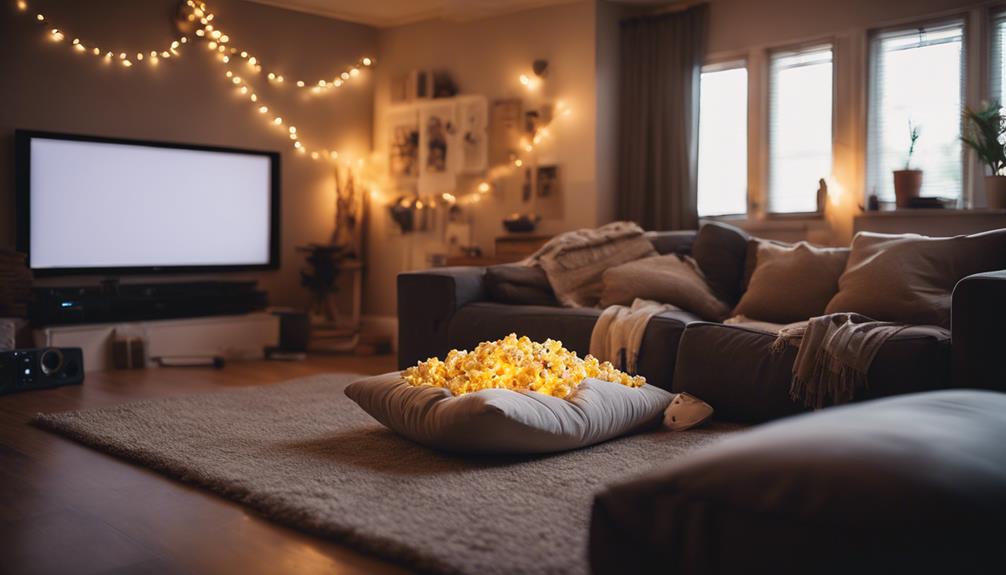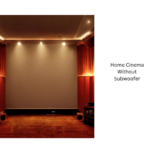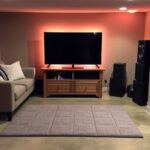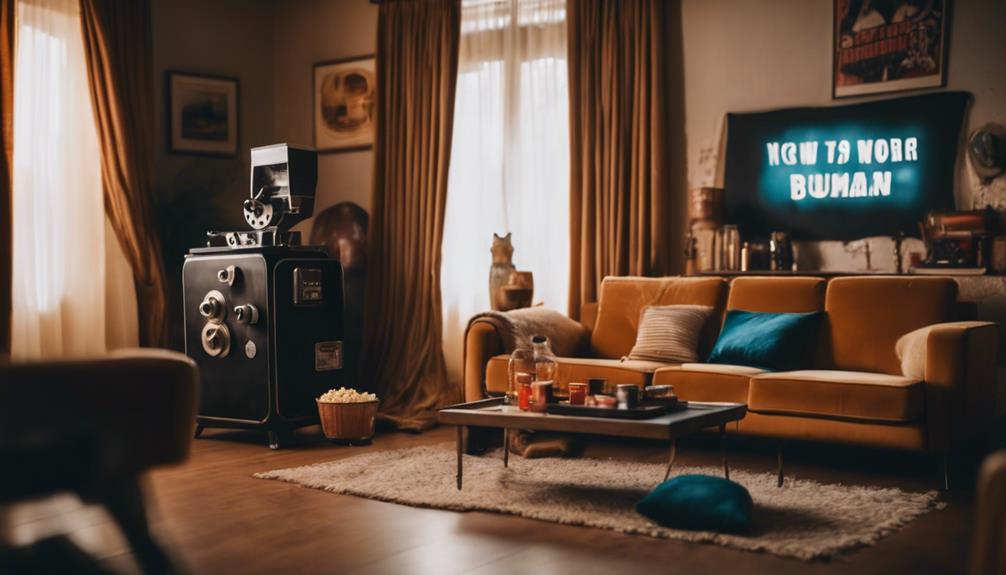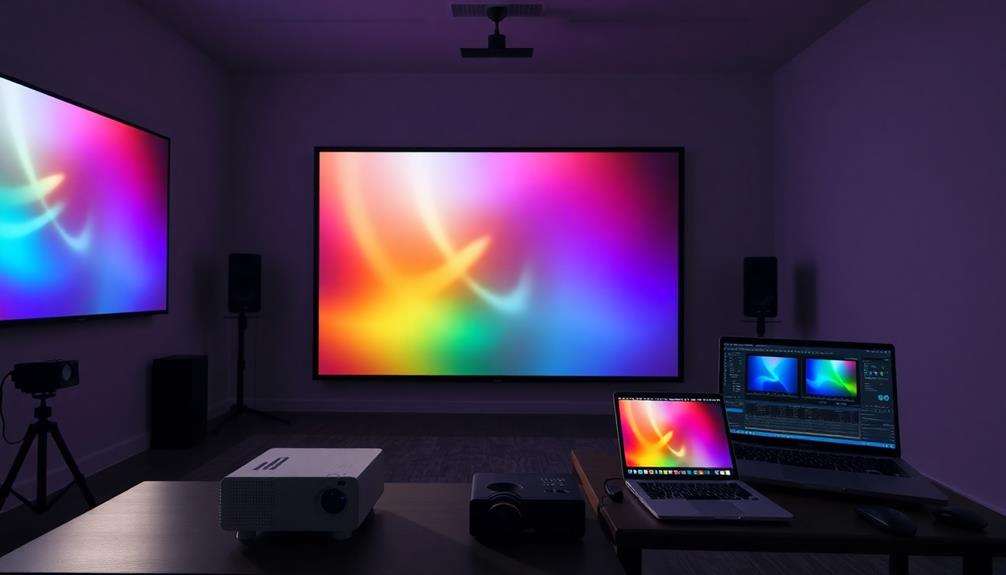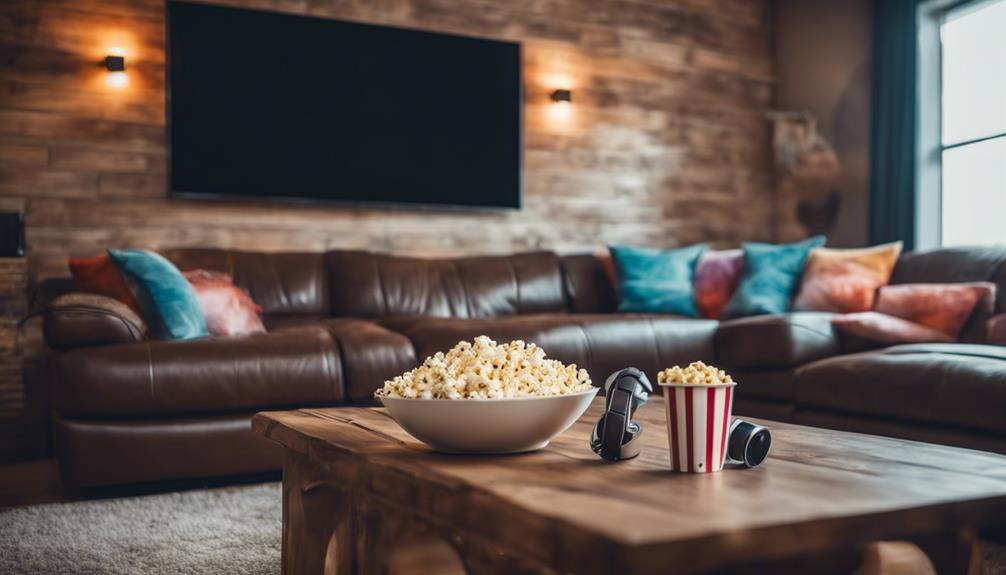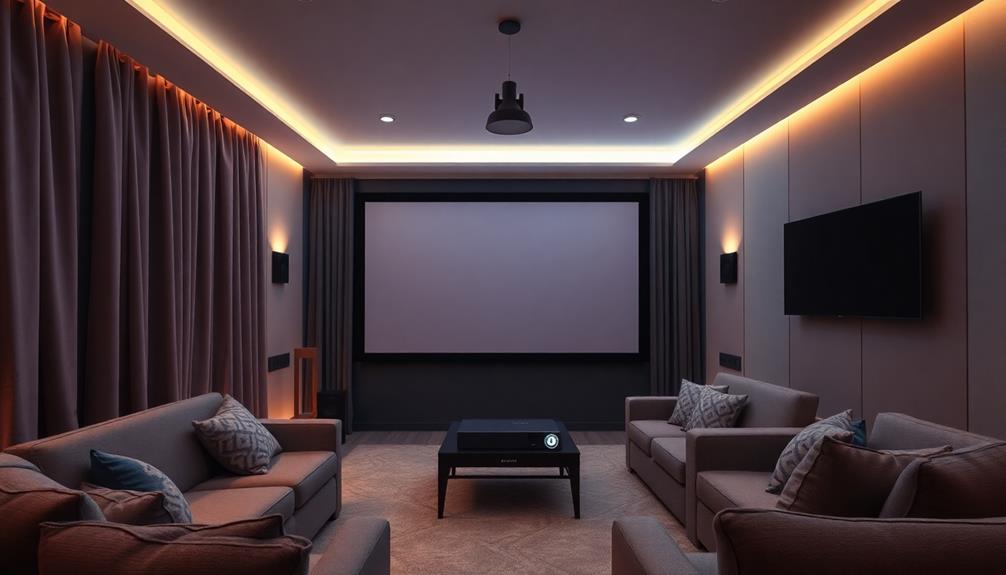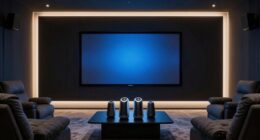You can create an impressive home cinema experience on a budget by choosing the right space and selecting quality equipment without overspending. Opt for a dimly lit room with comfortable seating, like bean bags or recliners, to enhance your movie nights. For visuals, a 4K TV or a quality projector like the Epson Home Cinema 4010 provides great value. Invest in a soundbar for immersive audio and use acoustic treatments, like rugs and curtains, to improve sound quality. With the right setup, your home cinema will feel luxurious. Stick around to uncover more tips for an amazing experience!
Key Takeaways
- Choose a room with minimal natural light and a rectangular layout for optimal viewing conditions and effective equipment setup.
- Select a high-resolution display like the TCL 65 Q6 QLED TV or Epson Home Cinema 4010 projector based on your budget and space.
- Enhance audio quality with affordable sound solutions such as soundbars or in-wall speakers, and consider refurbished equipment for savings.
- Implement dimmable lighting and blackout curtains to create an immersive ambiance that complements your movie-watching experience.
Choosing the Right Space
When choosing the right space for your home cinema, look for a room with minimal natural light to enhance your viewing experience and eliminate screen glare. A basement or an interior room works great for this purpose.
You'll want to verify there's ample wall space for projector placement or a large screen setup, as this is essential for achieving that cinematic feel.
Consider the size and layout of the room. A rectangular space allows for effective room setup and unobstructed sightlines, guaranteeing everyone has a great view of the screen.
When it comes to seating, opt for comfortable options like recliners or bean bags that fit well within the room size and provide ideal viewing angles.
To further enhance the ambiance, incorporate blackout curtains to block out any residual light. Dimmable LED lights are also a fantastic addition, allowing you to control the atmosphere during your movie nights.
Essential Equipment Selection
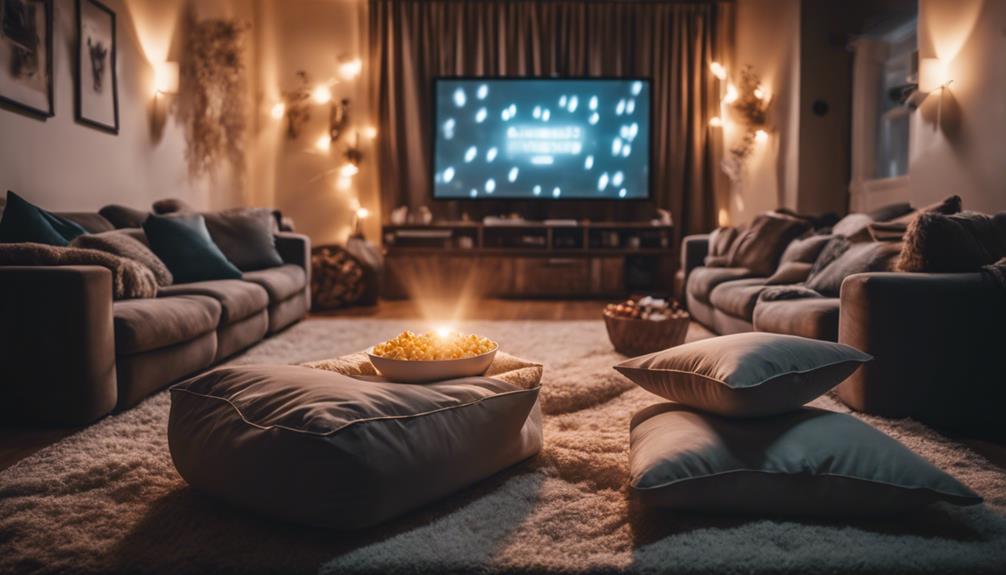
When setting up your budget home cinema, picking the right display, sound solutions, and accessories is key.
To enhance your audio experience, consider investing in best headphone amplifiers of 2024 to boost sound quality without overspending.
You'll want to balance quality with affordability to create an immersive experience.
Let's explore how to make smart choices for each essential component.
Choosing the Right Display
Selecting the right display is essential for creating a budget-friendly home cinema that delivers an impressive viewing experience. You have a couple of great options: a high-resolution 4K UHD TV or a projector. For an excellent value, consider the TCL 65 Q6 QLED 4K TV at around $499. If you prefer a projector, look at options like the Epson Home Cinema 4010, which offers a cinematic experience but requires attention to the throw ratio for ideal screen size.
Here's a quick comparison to help you decide:
| Display Type | Price Range |
|---|---|
| High-Resolution 4K UHD TV | ~$499 (TCL 65 Q6 QLED) |
| Projector (Epson 4010) | ~$2,000 |
| Affordable Mini Projectors | $300 – $2,000 |
| Screen Size (Elite Screens) | 150-inch diagonal |
| Ideal Brightness | 2800 ANSI lumens for well-lit spaces |
When choosing your display, consider the ambient light in your space. Brighter projectors perform better in well-lit environments, ensuring you enjoy vivid images during your movie nights.
Affordable Sound Solutions
Finding affordable sound solutions can elevate your home cinema experience without straining your budget. Start with soundbars, like the TCL Q Class 5.1 Channel model priced at $249, which includes a subwoofer and surround speakers. These budget-friendly options deliver high-quality sound, providing an immersive audio experience without the need for expensive equipment.
If you're on a tighter budget, consider external sound systems that start around $400. They offer a significant upgrade from built-in TV speakers without breaking the bank. Investing in high-quality speakers, such as the Polk Audio RC85i In-Wall speakers, can enhance sound quality while remaining budget-friendly, typically priced at around $150 per pair.
Don't overlook refurbished audio equipment; it can save you money while still providing reliable performance. Additionally, using acoustic panels, which you can create from affordable materials, can greatly improve sound quality in your home theater.
This approach allows for a significant enhancement in your audio setup, ensuring you get the immersive experience you desire without overspending. By choosing these budget-friendly audio solutions, you can achieve a satisfying home cinema environment that rivals more expensive setups.
Essential Accessories and Features
To create an impressive home cinema on a budget, you should focus on essential accessories and features that enhance both the visual and auditory experience. A well-thought-out home theater setup includes selecting the right audio equipment, a reliable streaming device, and some thoughtful enhancements.
Here's a quick overview of some essential items:
| Essential Accessory | Description |
|---|---|
| TV | TCL 65 Q6 QLED 4K TV – $499 for quality visuals |
| Soundbar | TCL Q Class 5.1 Channel – $249 for immersive audio |
| Lighting | Govee Dreamview Backlights – $90 for ambiance |
| Streaming Device | Roku Express/Amazon Fire Stick – $30-$50 |
Investing in a solid surround sound system, like the TCL soundbar, will greatly improve your movie-watching experience. Additionally, using sound-absorbing materials such as rugs and curtains can enhance acoustics, creating a more inviting atmosphere. If you're considering a projector screen, remember that it can elevate your visual experience as well. By prioritizing these budget-friendly essentials, you'll transform your home cinema into a delightful retreat for all movie nights.
Affordable Audio Solutions

Affordable audio solutions can transform your home cinema experience without breaking the bank. You don't need to invest in a pricey sound system to enjoy high-quality audio. Here are some budget-friendly options that deliver immersive sound:
- Soundbars: Consider the TCL Q Class 5.1 Channel soundbar for $249. It includes built-in surround speakers and a subwoofer, providing a complete audio experience.
- Bookshelf Speakers: Opt for budget-friendly bookshelf speakers or a simple 2.1 or 3.1 speaker system. They're easy to set up and offer a significant upgrade over your TV's built-in speakers.
- In-wall Speakers: Brands like Polk Audio offer affordable in-wall speakers, such as the RC85i, which maintain a clean aesthetic without sacrificing sound quality.
- Deals on Audio Equipment: Regularly check for deals on audio equipment, including refurbished items. You can save money while still achieving a great home theater experience.
With these affordable audio solutions, you can create an incredible sound environment that enhances your movie nights without emptying your wallet.
Optimizing Visual Display

Upgrading your visual display can greatly enhance your home cinema, complementing the immersive audio solutions you've already considered. For ideal image clarity, choose a projector with at least 1080p resolution, but if your budget allows, consider a 4K projector for a more vivid experience. The Epson Home Cinema 4010 4K PRO-UHD projector is an excellent choice at around $2,000 for budget-conscious cinephiles.
Pair your projector with a quality screen like the Elite Screens Sable Frame AcousticPro1080P3, which boasts a 150-inch diagonal size and sound transparency for stunning visuals. Don't forget to verify adequate throw distance by checking the projector's throw ratio to fit your room size without distortion.
If space is a concern, you might opt for a high-quality LED TV, such as the TCL 65 Q6 QLED 4K TV, priced at $499. It delivers impressive visuals while being budget-friendly and space-efficient.
| Feature | Recommendation |
|---|---|
| Projector | Epson Home Cinema 4010 4K |
| Screen | Elite Screens AcousticPro1080P3 |
| Image Clarity | 4K Preferred |
| Space Requirement | TCL 65 Q6 QLED 4K TV |
Lighting for Atmosphere

To set the right mood for your home cinema, you need to focus on dimmable lighting solutions that allow you to adjust brightness as needed.
Choosing the right color temperature can make a huge difference, with warmer tones enhancing the cinematic experience.
Additionally, controlling ambient light will help you create a comfortable and immersive viewing environment.
Dimmable Lighting Solutions
How can dimmable lighting transform your home theater into an enchanting cinematic experience? By setting the right ambiance, you'll elevate your movie nights to a whole new level. Here are some budget-friendly ideas to achieve that perfect atmosphere:
- Install Lutron Caseta Dimmers: This allows for easy lighting control, letting you adjust brightness based on the mood or type of film.
- Add Monroe Sconces: These fixtures provide vertical light without glare, enhancing your home theater decor while keeping the focus on the screen.
- Incorporate LED Strip Lights: Dimmable LED strip lights not only create a cinematic effect but also promote energy efficiency and longevity.
- Use Color-Changing Capabilities: With Commercial Electric LED Ultra Slim lights, you can match your lighting to the film theme, adding a dynamic flair to your viewing experience.
Color Temperature Importance
The color temperature of your lighting plays an essential role in creating the perfect atmosphere for your home theater, influencing everything from mood to comfort during movie nights. Warmer tones around 2700K can establish a cozy atmosphere, making your cinematic experience more enjoyable.
To optimize your lighting setup, consider using the following elements:
| Lighting Type | Benefits |
|---|---|
| Dimmable Lights | Control brightness for comfort |
| LED Lights | Adjustable color temperatures |
| Ambient Lighting | Enhances aesthetics, reduces glare |
| Dimensional Lights | Provides depth and visual interest |
Ambient Light Control
Controlling ambient light is essential for crafting an immersive atmosphere in your home cinema, ensuring that distractions fade away as the film begins. To achieve effective ambient light control, consider these key elements:
- Blackout curtains: Install these to block out external light, creating a darker environment that enhances your cinematic experience.
- Dimmable LED lights: Use 2700K temperature bulbs to set a warm, inviting atmosphere during movie viewing. Their adjustable brightness helps you control the mood effortlessly.
- Vertical lighting: Incorporate Monroe Sconces for soft, glare-free illumination. This adds depth and a cozy ambiance without overpowering the screen.
- Smart lighting systems: These allow remote control and programmable settings, enabling you to adjust lighting based on the movie genre or occasion.
DIY Design Tips
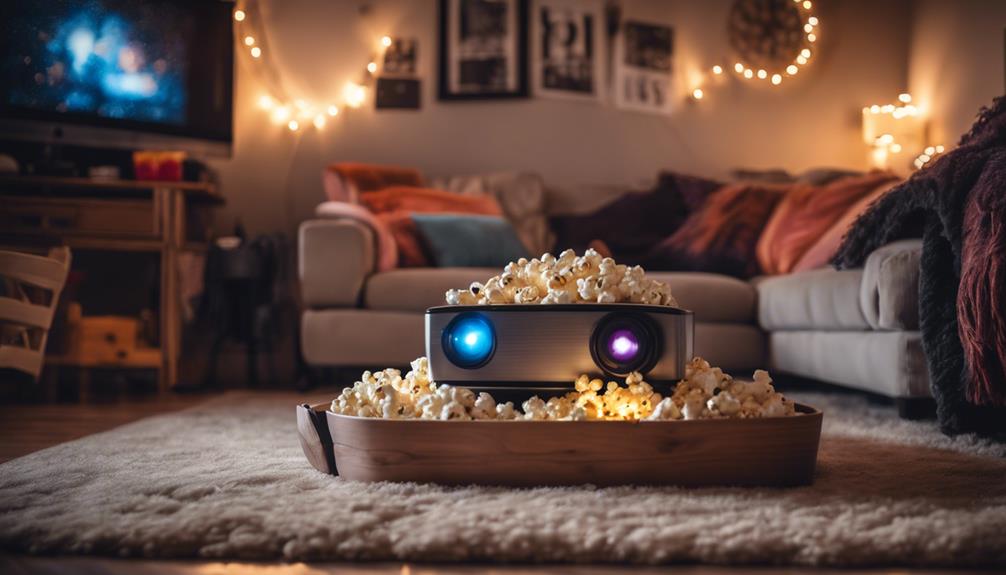
Transform your space into a cozy home cinema with simple DIY design tips that enhance both comfort and ambiance.
Start by choosing comfortable seating options like repurposed furniture or bean bags, ensuring everyone can relax during movie marathons.
Consider adding some best window treatments to enhance the overall aesthetics and privacy of your cinema experience.
For an impressive sound experience, consider adding acoustic panels or soft furnishings like rugs and thick curtains to absorb sound and improve audio quality.
Next, focus on lighting. Use smart lighting solutions, such as dimmable LED lights with a warm color temperature of 2700K, to create a cinematic ambiance that enhances your viewing experience.
You can also incorporate products like Govee Dreamview TV Backlights to complement the on-screen action without breaking the bank.
Acoustics and Soundproofing
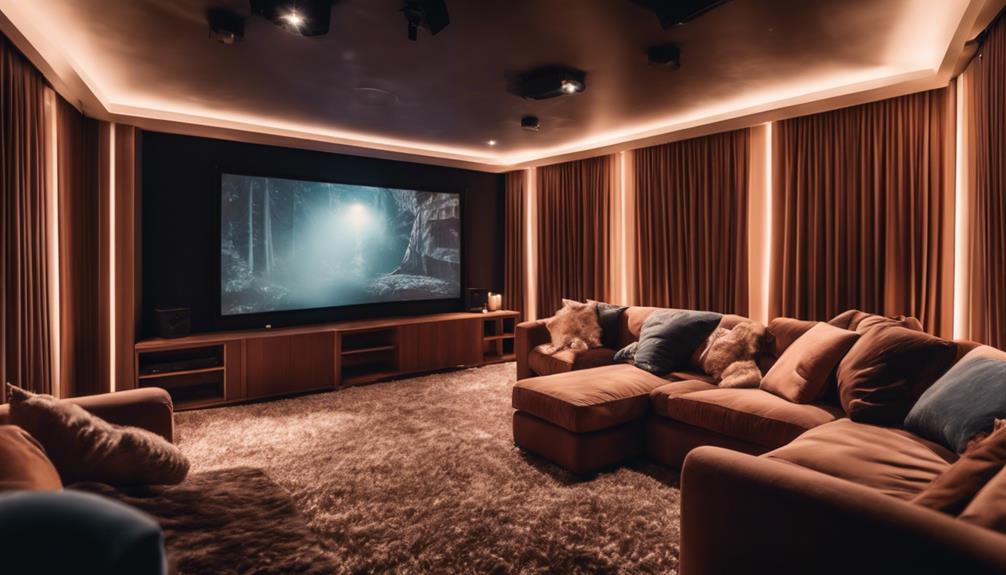
Enhancing your home cinema's acoustics and soundproofing can elevate your movie-watching experience, making every dialogue crisp and every sound effect immersive. You don't need to spend a fortune to achieve great audio quality. Here are some budget-friendly tips to improve the sound in your home theater:
- Use Rugs and Heavy Curtains: These materials help dampen sound and minimize echo, creating a richer audio environment.
- Install Acoustic Panels: Placing these on your walls can greatly reduce sound reflections, enhancing clarity for dialogue and effects.
- Seal Gaps: Prevent sound leakage by sealing gaps in doors and windows. This way, external noises won't disrupt your cinematic experience.
- Optimize Furniture Arrangement: Position your seating at least 1.5 to 2 times the distance of your screen size. This arrangement enhances sound distribution and immersion.
Enhancing Your Experience
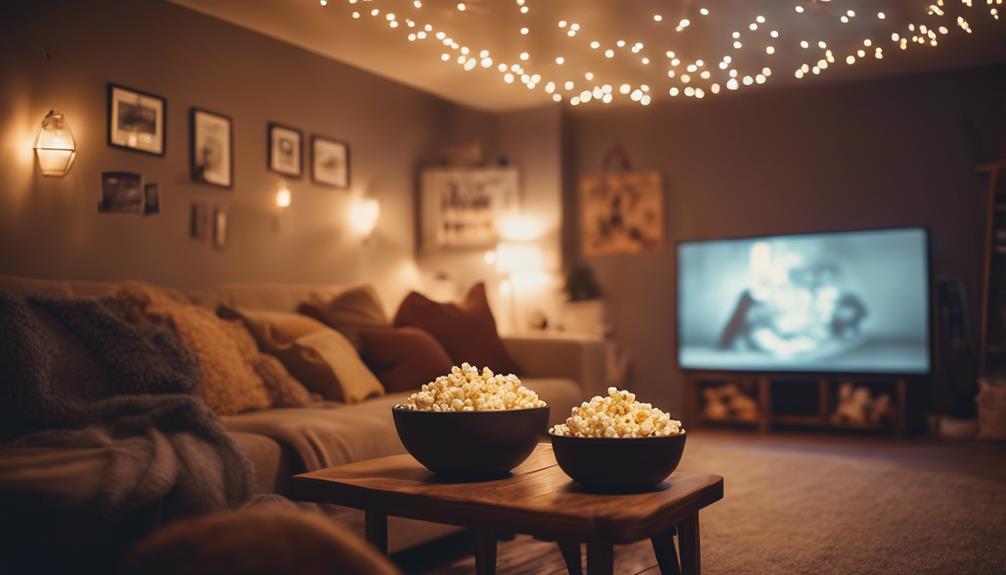
Creating the right atmosphere for your home cinema often involves careful attention to lighting and sound, ensuring you fully enjoy every cinematic moment.
Start by installing dimmable LED lights to create an adjustable ambiance. Aim for warm lighting around 2700K, enhancing the overall cinema experience. Blackout curtains can also eliminate external light interference, allowing for a more immersive viewing environment.
When it comes to audio, consider a budget-friendly home theater system. A soundbar or a 5.1 surround sound system, starting at around $249, can provide excellent audio without breaking the bank. This setup will deliver rich audio quality that brings your films to life. Pair your audio with a projector and screen that offer at least 1080p resolution. The Epson Home Cinema 4010 4K PRO-UHD projector is a solid choice, though there are more affordable options available.
Don't forget about acoustic treatments. Simple additions like rugs and curtains can greatly improve sound quality and reduce noise, creating a more enjoyable viewing experience.
With these enhancements, you're well on your way to a fantastic home cinema, all while staying budget-friendly.
Frequently Asked Questions
How to Make a Movie Theater Experience at Home?
To create a movie theater experience at home, invest in a quality projector and sound system, use dimmable LED lights, add blackout curtains, and arrange comfortable seating for an immersive viewing environment you'll love.
How Do You Make a Perfect Home Cinema?
To create the perfect home cinema, think of it as crafting a cozy nest. Choose a dark room, invest in a great projector, set up quality audio, and control the lighting for an immersive experience. Enjoy!
How Do Independent Theaters Make Money?
Independent theaters make money through ticket sales, concessions, and special events. They boost revenue with membership programs and loyalty cards, plus collaborate with local businesses for promotions, enhancing community support and profitability.
How Much Does a Home Theatre Room Cost?
Setting up a home theater room can feel like you're building a spaceship! Depending on your choices, costs typically range from $1,000 to $5,000. You can create a fantastic space without emptying your wallet!
Conclusion
So, you thought creating a budget-friendly home cinema was impossible, huh? Surprise!
With just a little creativity and smart choices, you can enjoy movie nights without a Hollywood budget.
By transforming your space and picking the right gear, you'll be amazed at how quickly you can elevate your viewing experience.
Who knew saving money could feel so luxurious?
Now, grab that popcorn and settle into your new cinematic paradise—who needs a fancy theater anyway?
